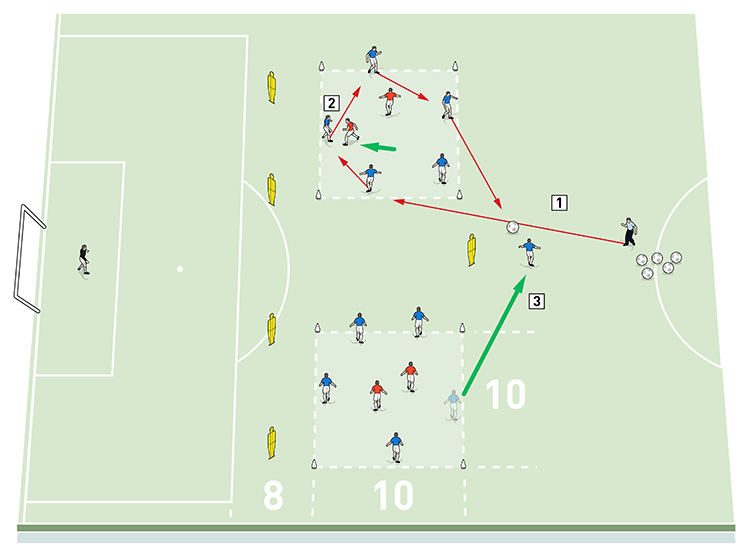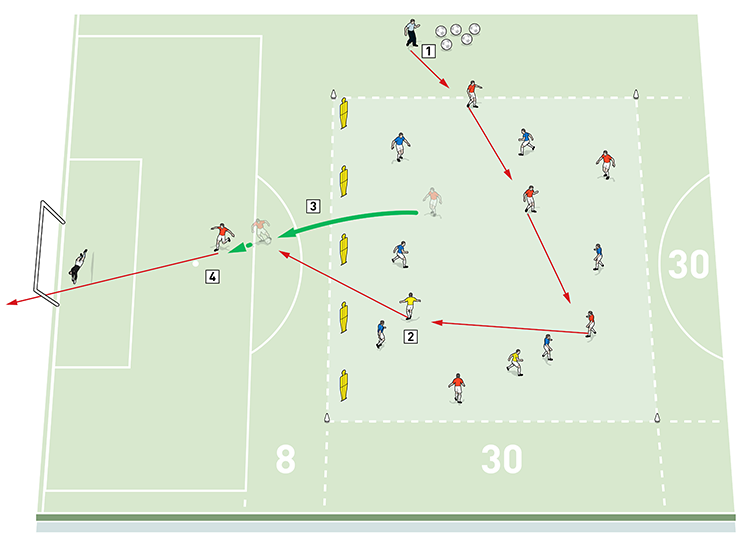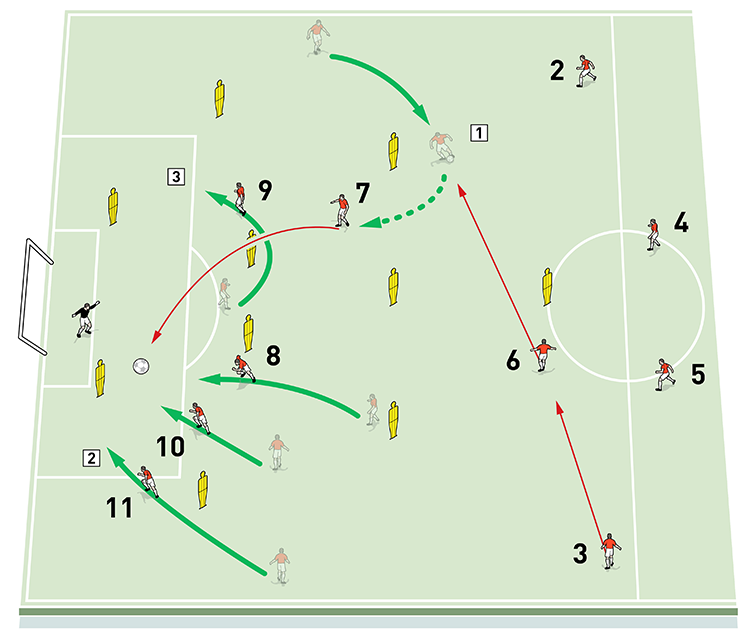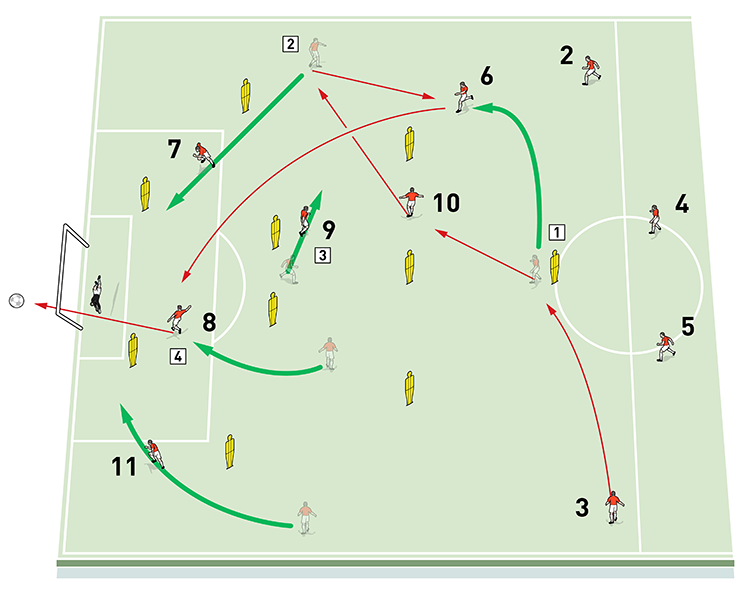You are viewing 1 of your 1 free articles
Penetration in the final third
This session is about breaking lines and penetration. It focuses on getting the wide players, the midfielders and the centre forward running beyond opposing defenders in the final third.
| Area | Up to two thirds of pitch |
| Equipment | Balls, bibs, cones, 10 mannequins, 2 goals |
| No. of Players | Up to 20 players + 2 goalkeepers |
| Session Time |
Switch and penetrate: 10mins, Break out and penetrate: 12mins, Penetration play: 20mins, 11v11 game (not shown): 12mins |
This session is about breaking lines and penetration. It focuses on getting the wide players, the midfielders and the centre forward running beyond opposing defenders in the final third.
The reason we work continually on
this type of session at training is to establish programmed movements in certain scenarios. Players have a tendency to always come to feet and we have a lot of pace in our side, especially up front and in wide areas, so we regularly work on getting behind defenders and making penetrating runs that emphasises our pace.
We work on certain triggers and the position of the opposition to try and exploit areas in behind the back four and midfield. We feel we need to do this type of session at least twice a week in some format as we tend to be a team always looking for more passing options, even in the final third.
In the early part of the week we would run this session, or one like it, solely with the forward players. Then we would add the midfielders. The day before a game we would combine the whole team in the forward pattern and bring the units together.
We feel the programmed movements developed in this session are vital to establish our three stages of attack: build up with patience, move the opposition in the middle area, and penetrate in the final third.
SWITCH AND PENETRATE
We set up in the final third of the pitch with a goal and goalkeeper in their usual positions. We mark two 10x10-yard boxes side by side about 26 yards from the goal and we position five mannequins as shown, with four of them representing the defensive backline and one representing a defensive midfielder.
We’re using 14 outfield players (usually made up of midfielders and strikers), with a 5v2 in each box. The coach starts play with a pass into the box and the team of five attackers must pass to keep possession. After the team makes three passes, one of the five attackers from the other box moves out at an angle to receive a pass, as shown [1a], and then in turn plays the ball into the box he came from. One player is then released from that box to run past the mannequins onto a through pass in the penalty area, as shown [1b]. The player penetrating the penalty area is allowed two touches to get a shot off on goal.
1a

2. The two red defenders press and try to win possession. If they succeed, they should clear the ball out of the box
3. After the possession team makes three passes in one box, an attacker from the other box moves out at an angle to receive a pass
1b

2. One attacker is released to run past the mannequins onto a through pass and into the penalty area. He is allowed two touches to get a shot off
3. After he has shot, the attacker must recover to his starting box
4. The blues receive a new ball from the coach and must pass 4v2 until the recovering attacker returns to make it 5v2. Play then continues as before
The drill is continuous and as the coach plays another ball into the box that the attacker came from, his team mates play 4v2 until the recovering attacker makes it 5v2 again. Play continues as before.
To progress the practice, we can ask the two pressers in each box to press three times each and then switch places with an attacker.
In this drill we work on the weight of pass and the timing of the run. We also emphasise the switch of play from one area to another, as we feel this is when the defending team are outnumbered and more vulnerable.
We work with the players on their decision making as we find they can make poor decisions about when to play the penetrating pass.
BREAK OUT AND PENETRATE
We progress the previous activity by replacing the two 10x10-yard boxes with one 30x30-yard box positioned about 26 yards from the goal. It contains four mannequins that represent a defensive backline. We’re using 14 outfield players split into two teams of six and two floaters who play for the possession team.
The coach starts by playing a ball into the box and the possession team passes under pressure from their opponents. After completing the third pass, the possession team plays a through ball for a player to run onto beyond the mannequins. The breakout attacker must get a shot off within two touches, as shown [2].
2

2. The two floaters play for the team in possession
3. After the third pass, the possession team must play a through ball for a player to run onto beyond the mannequins
4. The breakout attacker has to get a shot off within two touches. He then recovers to join his team in pressing their opponents, who have been served a new ball
After the shot has been taken, the coach plays a new ball into the 30x30-yard box while the breakout attacker is recovering. Play continues with the other team passing until they achieve three passes and trigger a breakout themselves. We play three games of three minutes.
We can progress this activity so that only the floaters can play the penetrating pass. We can also remove the three-pass trigger to allow players to assess the best times to penetrate. This ensures players understand when to keep possession and teaches them that they shouldn’t force the play.
PENETRATION PLAY
For the following patterns of play, we set up on just over half a pitch with a goal and a goalkeeper at one end. Ten mannequins are used to represent the opposition, set up as if they were in a 4-2-3-1 formation and positioned as shown.
We’re using 20 outfield players split into two teams of 10. Only one team runs each drill at a time and the other waits to take a turn. We look at various programmed movements, continuing the theme of penetration and forward runs. We want to see the players controlling the possession in midfield and realising that we can’t penetrate every time. We encourage patience while we try to move the opposition from side to side to then penetrate. As this drill is unopposed, the trigger for the attack can be signalled by the coach’s whistle if necessary.
In the first pattern of play we work the ball around the midfield until the coach whistles or until the opportunity arises to play it high to the number 8, triggering the wide players to penetrate using the number 9 as a decoy, as shown [3a].
3a

2. The pass to the number 8 triggers the wide players 7 and 11 to make penetrating runs into the penalty area
3. The number 9 comes short to act as a decoy, as if to draw defenders away
In the second pattern, we work the ball around the midfield until the coach triggers the attack with his whistle. The wide player number 7 finds space in the pockets behind the midfield to receive the ball. This is the trigger for the opposite wide player 11, plus the numbers 8, 9 and 10 to penetrate, as shown [3b].
3b

2. The movement of the number 7 is the trigger for the opposite wide player to make a penetrating run
3. The move also triggers penetrating runs from the number 8, the number 9 and the number 10
In the third pattern, we work the ball around the midfield until the coach triggers the attack with his whistle. This time we change the point of attack to the number 6 who triggers the penetration from wide player 11 and number 8. The ball is worked wide to number 7, allowing the number 8 to penetrate beyond and the number 9 to come short as a decoy, as shown [3c].
3c

2. The ball is worked wide to number 7, who plays back to the number 6
3. The number 9 comes short as if to receive the ball
4. The number 6 launches the ball into the box in the direction of the number 8, who along with the two wide players has made penetrating runs into the final third
In these patterns of play we want to see players timing their runs to perfection and using the correct weight of pass. Players must also make good decisions about when and where to penetrate.
Related Files
Editor's Picks
Deep runs in the final third
Using the goalkeeper in build-up play
Pressing principles
Intensive boxes drill with goals
Penetrating the final third
Creating and finishing
My philosophy
Pressing initiation
Compact team movement
Coaches' Testimonials

Alan Pardew

Arsène Wenger

Brendan Rodgers

Carlos Carvalhal

José Mourinho

Jürgen Klopp

Pep Guardiola

Roy Hodgson

Sir Alex Ferguson

Steven Gerrard
Coaches' Testimonials

Gerald Kearney, Downtown Las Vegas Soccer Club

Paul Butler, Florida, USA

Rick Shields, Springboro, USA

Tony Green, Pierrefonds Titans, Quebec, Canada
Join the world's leading coaches and managers and discover for yourself one of the best kept secrets in coaching. No other training tool on the planet is written or read by the calibre of names you’ll find in Elite Soccer.
In a recent survey 92% of subscribers said Elite Soccer makes them more confident, 89% said it makes them a more effective coach and 91% said it makes them more inspired.
Get Monthly Inspiration
All the latest techniques and approaches
Since 2010 Elite Soccer has given subscribers exclusive insight into the training ground practices of the world’s best coaches. Published in partnership with the League Managers Association we have unparalleled access to the leading lights in the English leagues, as well as a host of international managers.
Elite Soccer exclusively features sessions written by the coaches themselves. There are no observed sessions and no sessions “in the style of”, just first-hand advice delivered direct to you from the coach.









